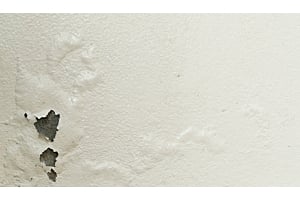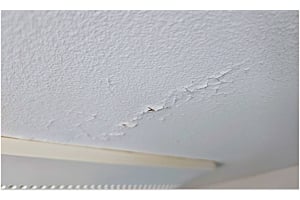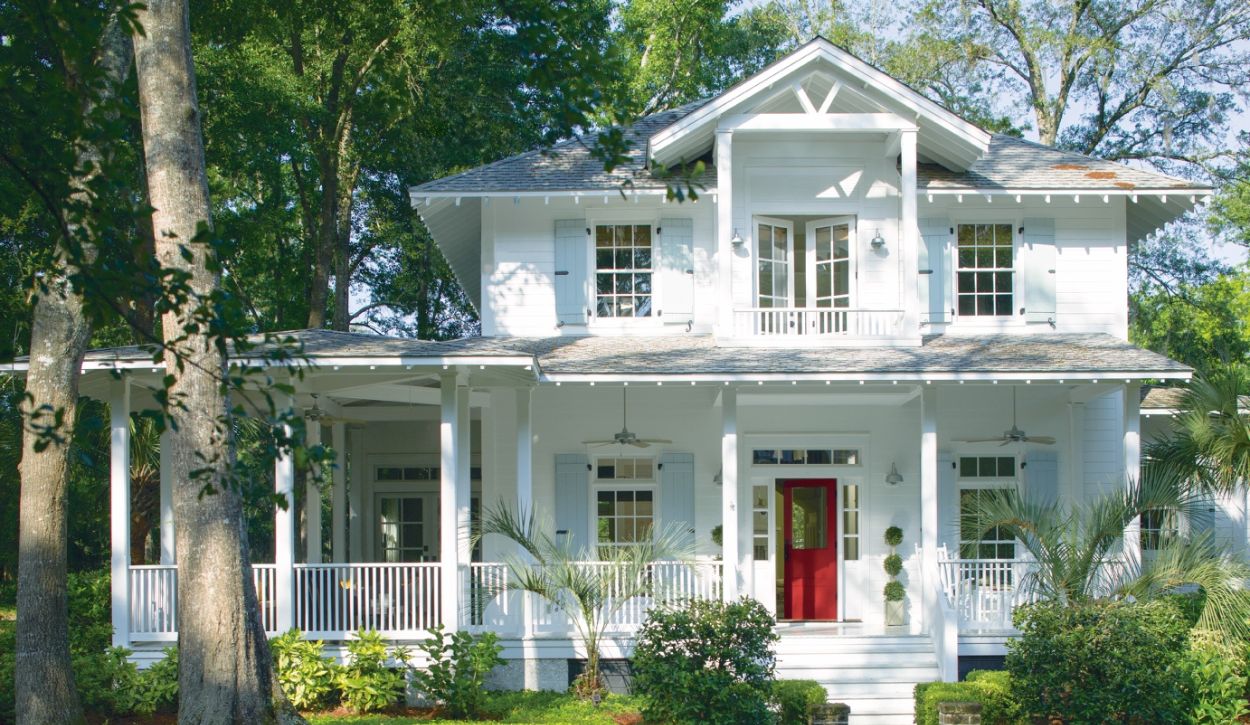
When it comes to transforming the look of your home, few home improvement projects have as much impact as fresh exterior paint. An updated color scheme boosts your home’s curb appeal, and a professional-grade paint job will protect your home’s exterior from the weather for many years.
Before tackling such a large project, it’s important to understand the materials you are working with and find the right type of paint and palette for your home’s exterior. We’re here to help with a comprehensive guide on product and planning tips from our paint pros!
Your Home’s Exterior Material
Understanding the materials on your home’s exterior is the first step to choosing the correct paint and primer for your project. While most exterior surfaces can be repainted with either an acrylic or a latex paint, some materials require specialty primers or certain types of paint.
Wood
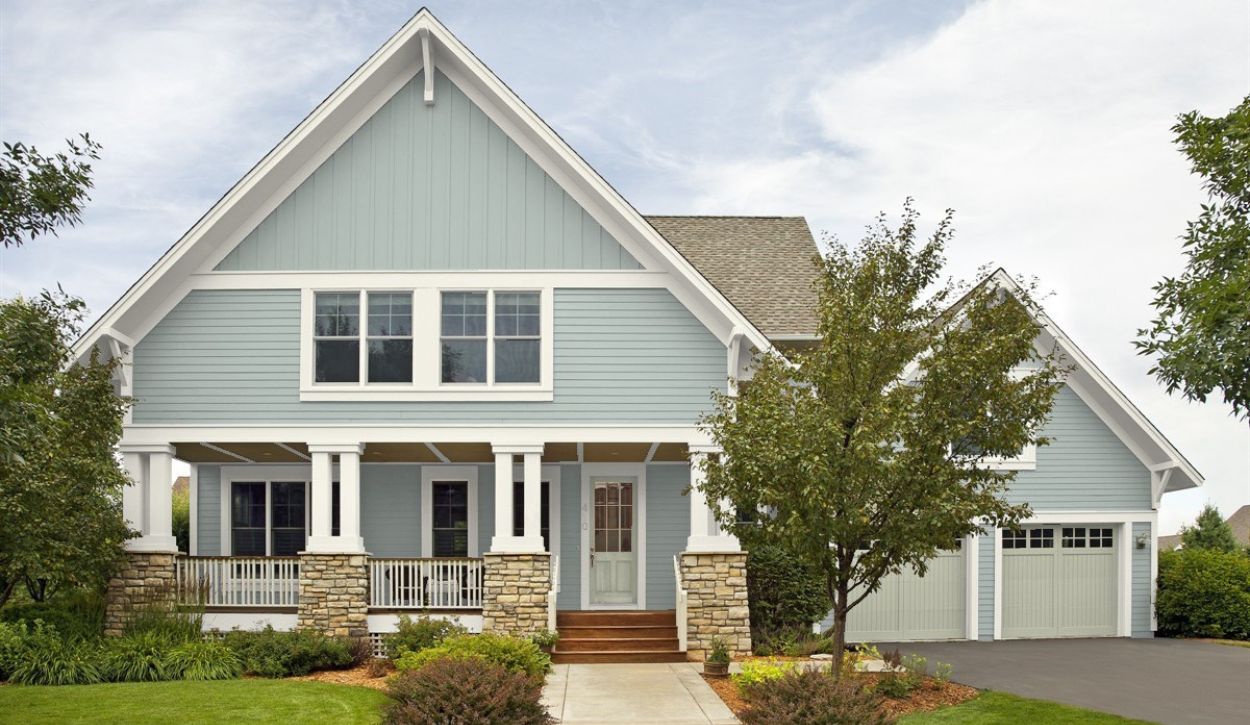 Benjamin Moore exterior paint: wood siding in Beach Glass, trim in White Dove, Doors in October Mist
Benjamin Moore exterior paint: wood siding in Beach Glass, trim in White Dove, Doors in October Mist
Wood siding is a popular material, especially on older homes, but it requires a durable coating to withstand the elements. Whether the wood is unpainted or has old paint, it should be coated with a primer to seal the surface and help the paint adhere. Primer also helps encapsulate lead paint, which is often found on older wood homes. Cracks and seams need to be caulked as well. Because wood expands and contracts with temperature changes, it’s important to choose a high-quality exterior paint that is flexible and water-resistant. Read on for our recommendations on the best exterior paint for a long-lasting finish.
Brick
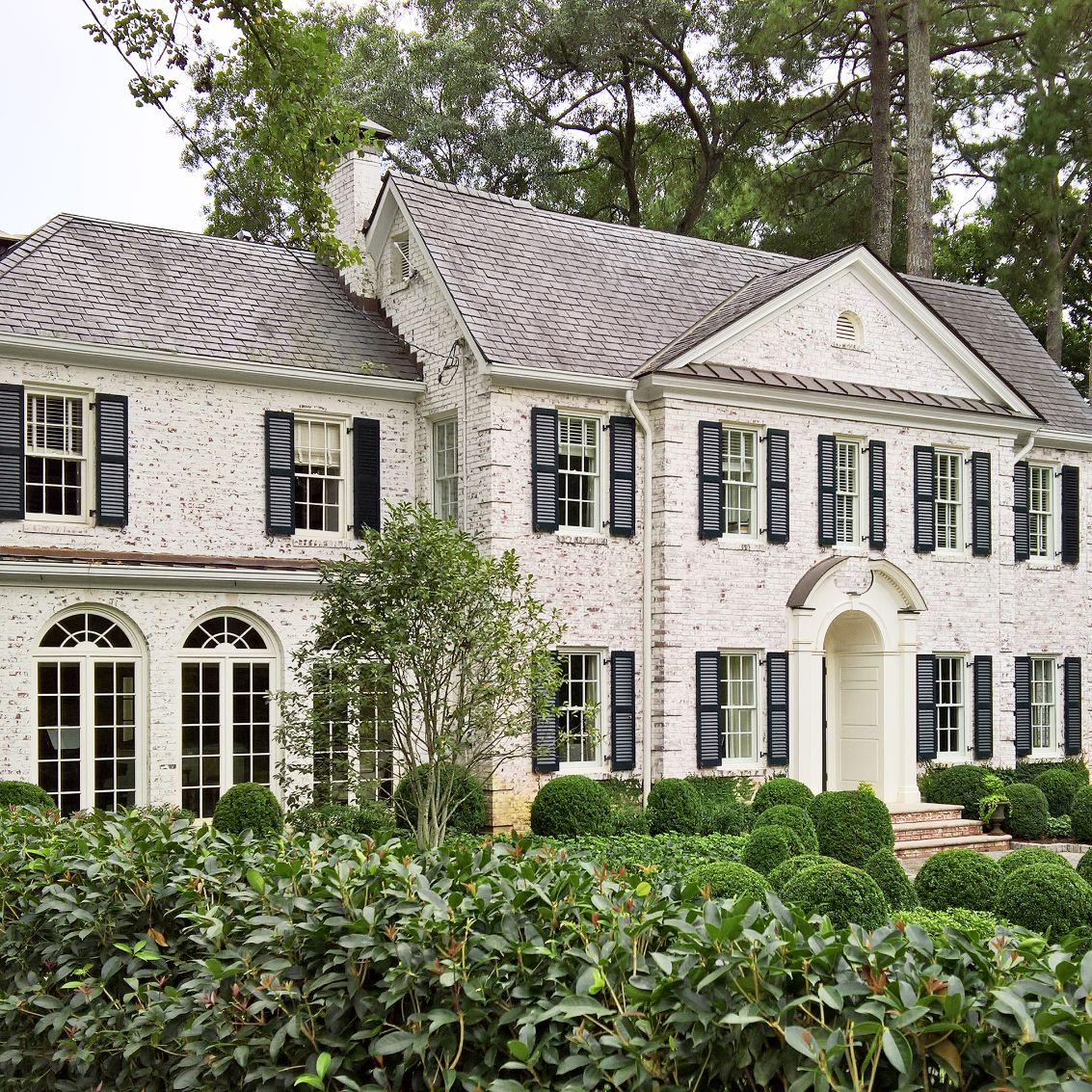 Brick home painted with Limewash by Romabio
Brick home painted with Limewash by Romabio
Brick is a long-lasting option for home exteriors and has timeless appeal. Because brick is porous, it can draw dampness from the ground, and that moisture must be able to dissipate. Never use oil-based or acrylic paints on brick because they trap moisture, which is severely damaging to brick over time. Instead, use masonry paint or limewash that will let the brick “breathe” so moisture can escape. These specialty paint formulas form a deep bond with the brick surface that prevents blistering and peeling paint.
Concrete Board Or Fiber Cement
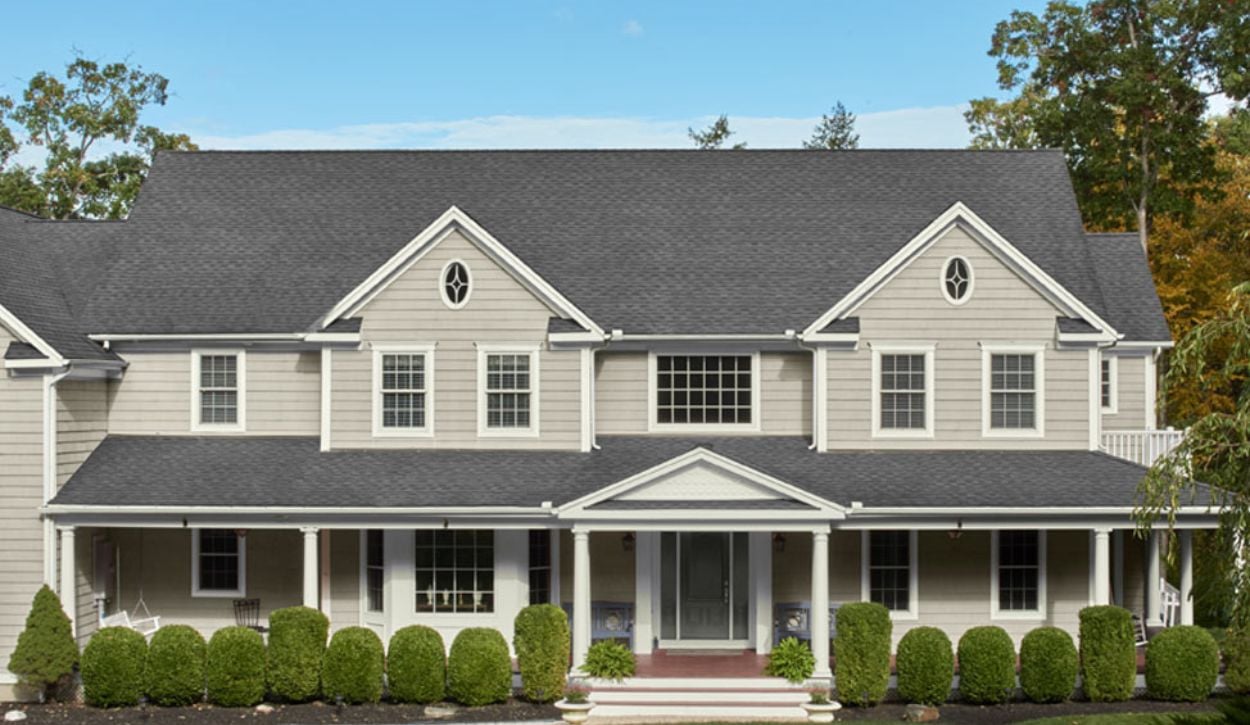 Fiber Cement siding in Revere Pewter by Benjamin Moore
Fiber Cement siding in Revere Pewter by Benjamin Moore
Also known as fiber cement siding, concrete board is a durable, versatile exterior siding material that has become very popular in recent years. Be sure to closely check your home’s exterior because it can look very similar to wood siding, shingles, stone, or stucco. Some manufacturers offer prefinished fiber cement siding with baked-on paint coatings, and some are painted on-site. Just like wood, concrete boards will need a primer coat to ensure good adhesion of the top coat.
Stucco
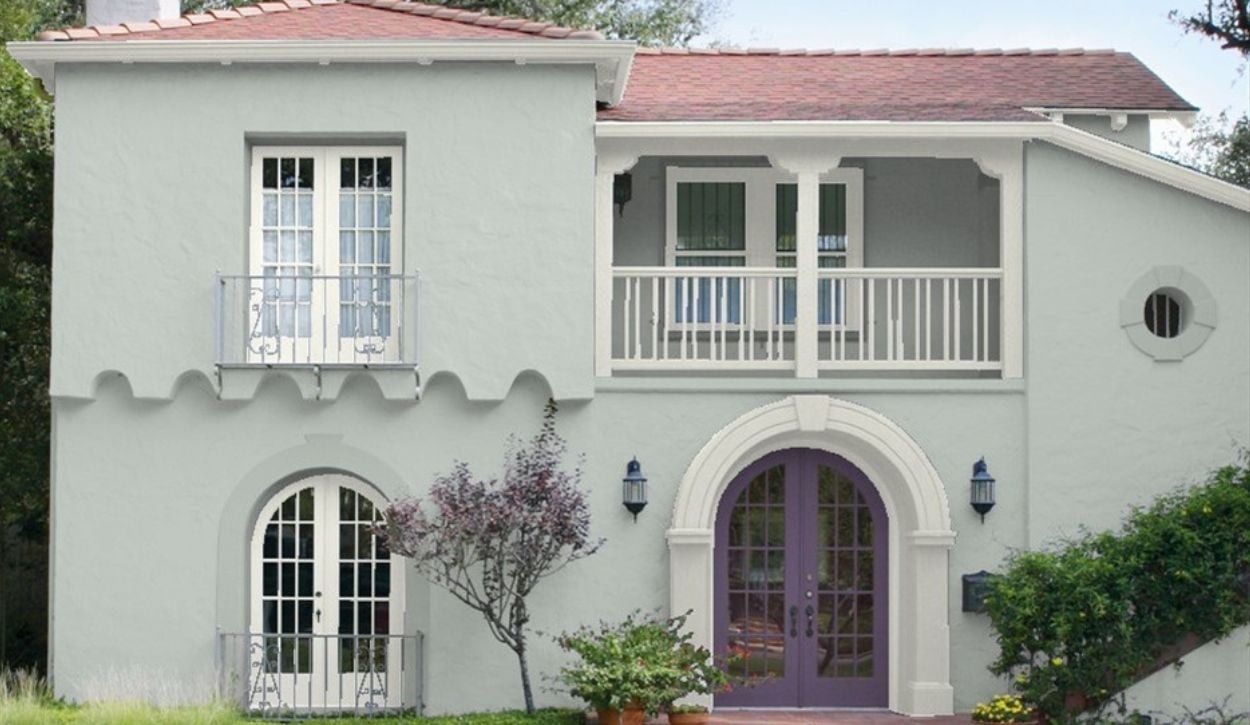 Stucco exterior painted Benjamin Moore Silver Marlin
Stucco exterior painted Benjamin Moore Silver Marlin
Stucco is a textured finish commonly found on Mediterranean and Spanish-style homes. There are two types; traditional stucco (which has a hard surface) and EIFS, or Exterior Insulation Finishing System, which is a bit softer. Both types are prone to cracking, so plan on patching and filling all cracks first and then wait a week before painting. Benjamin Moore recommends priming stucco walls with Ultra Spec Masonry 100% Acrylic Sealer and following up with two coats of exterior paint. Because of its texture, the most efficient way to paint stucco is with a paint sprayer, so if your home’s exterior is stucco you may want to hire a professional.
Vinyl
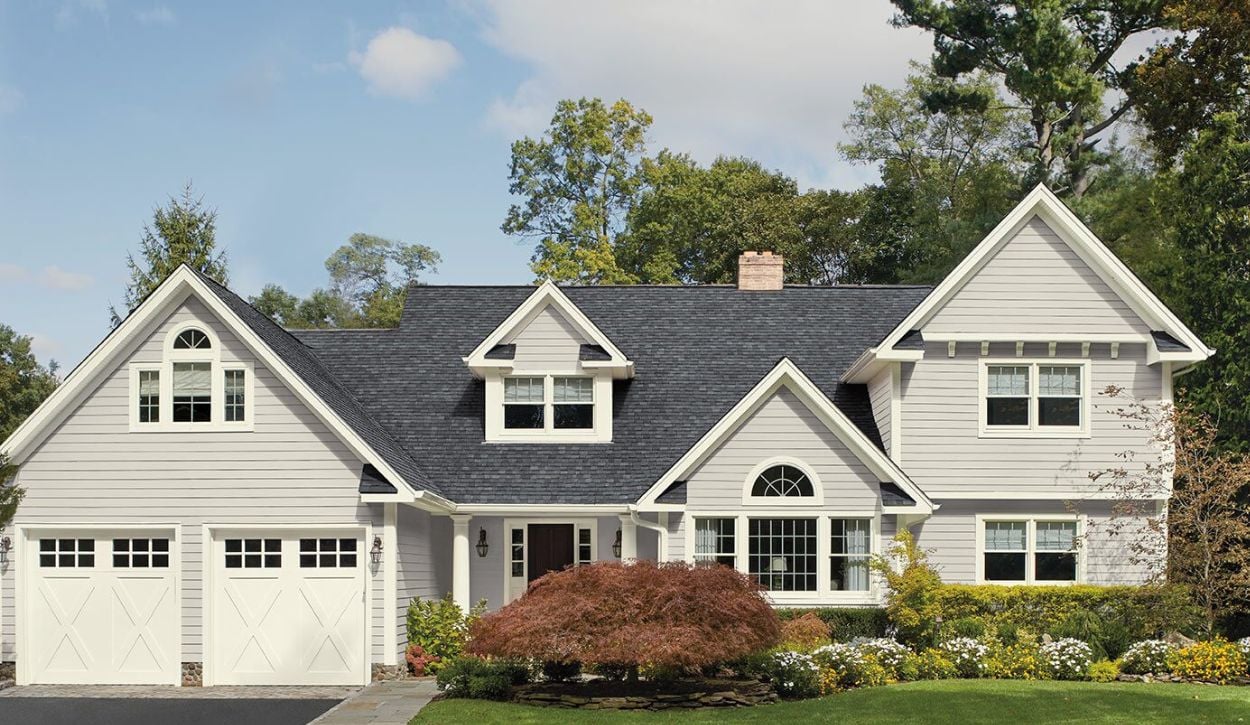 Benjamin Moore Vinyl Colors Stonington Gray and White Wisp
Benjamin Moore Vinyl Colors Stonington Gray and White Wisp
Vinyl siding is popular because it’s a low-maintenance, affordable building material that typically doesn’t need to be painted unless a homeowner wants a different exterior color. For a paint job that will last, use paint specially formulated for vinyl, which can expand and contract with temperature fluctuations. It’s crucial to select a paint that offers proper adhesion and will accommodate weather changes without cracking.
Vinyl is difficult for paint to adhere to properly, making your coat of primer all the more important. For vinyl siding, we recommend INSL-X STIX Waterborne Bonding Primer. This versatile product is designed for maximum adhesion on the most difficult substrates. (Note that it is never recommended to paint drastic color changes on vinyl, as the vinyl can get too hot and cause the coating to fail — even with the best primer.)
The Right Exterior Paint Products
For beautiful and lasting results, it’s critical to select the right exterior paint product for your home’s specific exterior. High-quality paint may seem expensive, but it is cost effective because it contains more pigments and solid particles, covering your home exterior in fewer coats. Professionals like to use brands like Benjamin Moore because it builds coverage faster and lasts longer.
The best choice for most exterior painting projects is an acrylic latex paint like Benjamin Moore’s AURA Exterior Paint or Regal Select High Build. These high-end paints also contain UV protectants which make them fade-resistant. They’re water-resistant, more elastic so they expand and contract with the surface, and specially formulated to deter mildew growth.
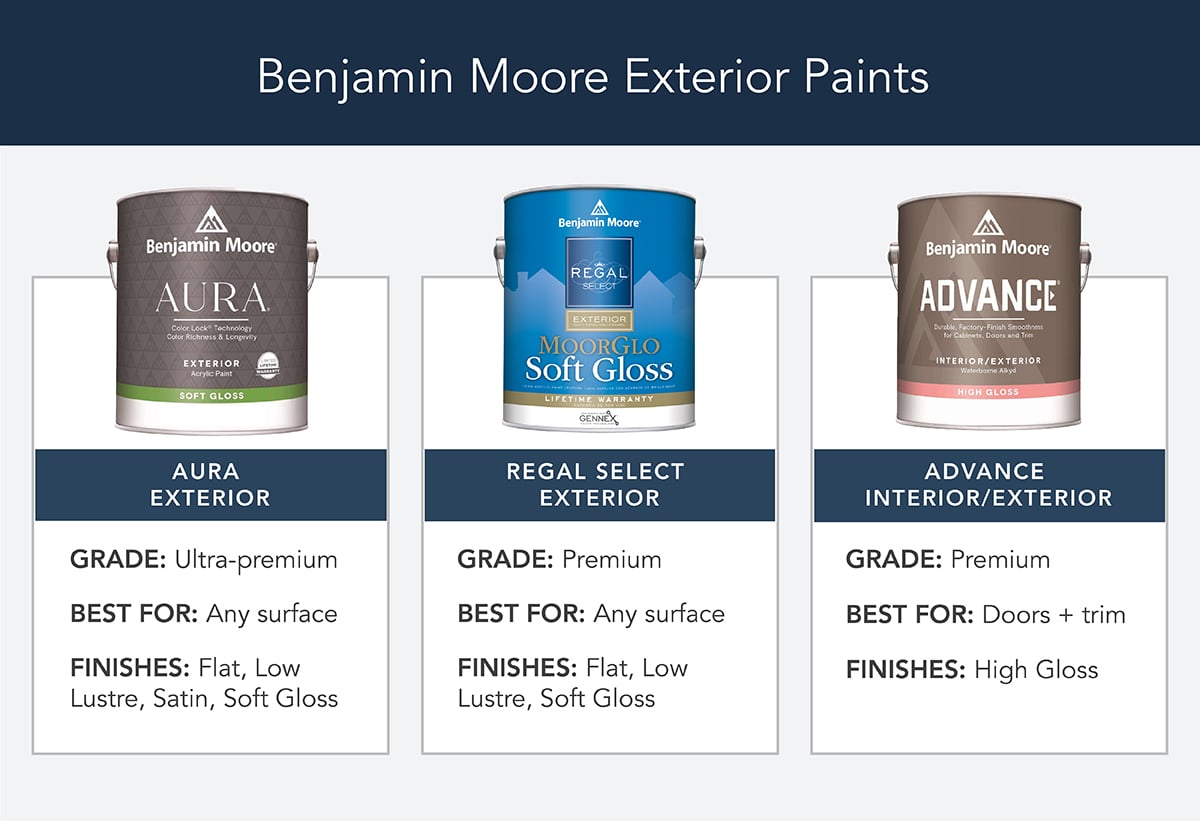
For an in-depth look at our Benjamin Moore exterior paints and tips on how to pick exterior colors, be sure to check out our comprehensive guide to Benjamin Moore Exterior Paint Products, Grades & Finishes.
How Much Paint You Will Need
Calculating the amount of paint needed for the exterior of your home is a straightforward process. Follow these simple steps:
1. Measure Your Exterior Surface Area:
- Measure the height and width of each section of wall.
- Multiply the height by the width for each surface to find its total area in square feet. For example, 20 feet wide x 12 feet tall = 240 square feet. For odd-shaped areas, you’ll need to do a little geometry!
- Add the square footage of all surfaces together to get the total surface area. For example, 4 walls x 240 = 960 square feet to be painted.
2. Check Paint Coverage:
- Check the paint can label for the paint’s coverage rate or the number of square feet it will cover per gallon (sq. ft./gal).
3. Divide the Exterior Surface Area by the Paint Coverage Rate:
- Divide the exterior surface area by the paint coverage rate for an estimate of how many gallons of paint you need for one coat. With coverage of 400 sq.ft./gal, calculate: 960 ÷ 400 = 2.4 gallons.
- Round up to full gallons, and double the amount for two coats. In our example, you’ll need 6 gallons of paint. If you’re using primer, you’ll need 3 gallons for a single coat of primer.
Remember, it’s better to have extra paint so you don’t risk running out in the middle of your project.
Paint Colors and Finishes
Your home’s architectural style and surrounding landscape can be great inspiration for your exterior color scheme. If you’re painting the entire home, you’ll need to choose colors for the siding, trim, and front door, and perhaps an accent color for shutters or other details. Paint brands like Benjamin Moore offer pre-selected exterior paint palettes that make it easy to see how different colors work together. Try matching shades to stone or brick accents on your home; and make sure the colors also blend with the roof, decking, and landscaping materials.
Choosing an exterior color scheme can be a big project in itself; that’s why we’ve created a handy guide to help. For creative exterior color ideas and inspiring images, check out Exterior Paint Colors & Trends For 2023.
Leaning toward dark paint colors?
Homeowners should be aware that black paint and dark paint colors with black pigments easily overheat in the sun and can damage the surface they’re applied to, especially if it is facing east or west. Depending on what you are painting, this can void your product warranty. Dark paint colors work best in north-facing facades or shaded areas, but homeowners should always take this risk into consideration when selecting the color palette for their home exterior.
Best Sheen for Exterior Paint
The sheen, or finish of a paint refers to how shiny it looks, or how much light is reflected off the surface. Exterior paint finishes range from flat (matte, non-reflective finishes generally used for siding) to high gloss (shiny, reflective finishes typically used for doors).
Most people use a flat sheen on exterior siding, and a satin or semi-gloss on trim details like window casings, porch railings, gutters, etc. Flat paint finishes provide better coverage, help hide imperfections, and are easier to apply. Semi-gloss and high-gloss sheens are easy to clean and highlight architectural details, making them ideal for the front door. However, glossy sheens also expose surface imperfections. Be sure to fill all dents, caulk all gaps, and sand the surface thoroughly to prepare for a glossy finish.
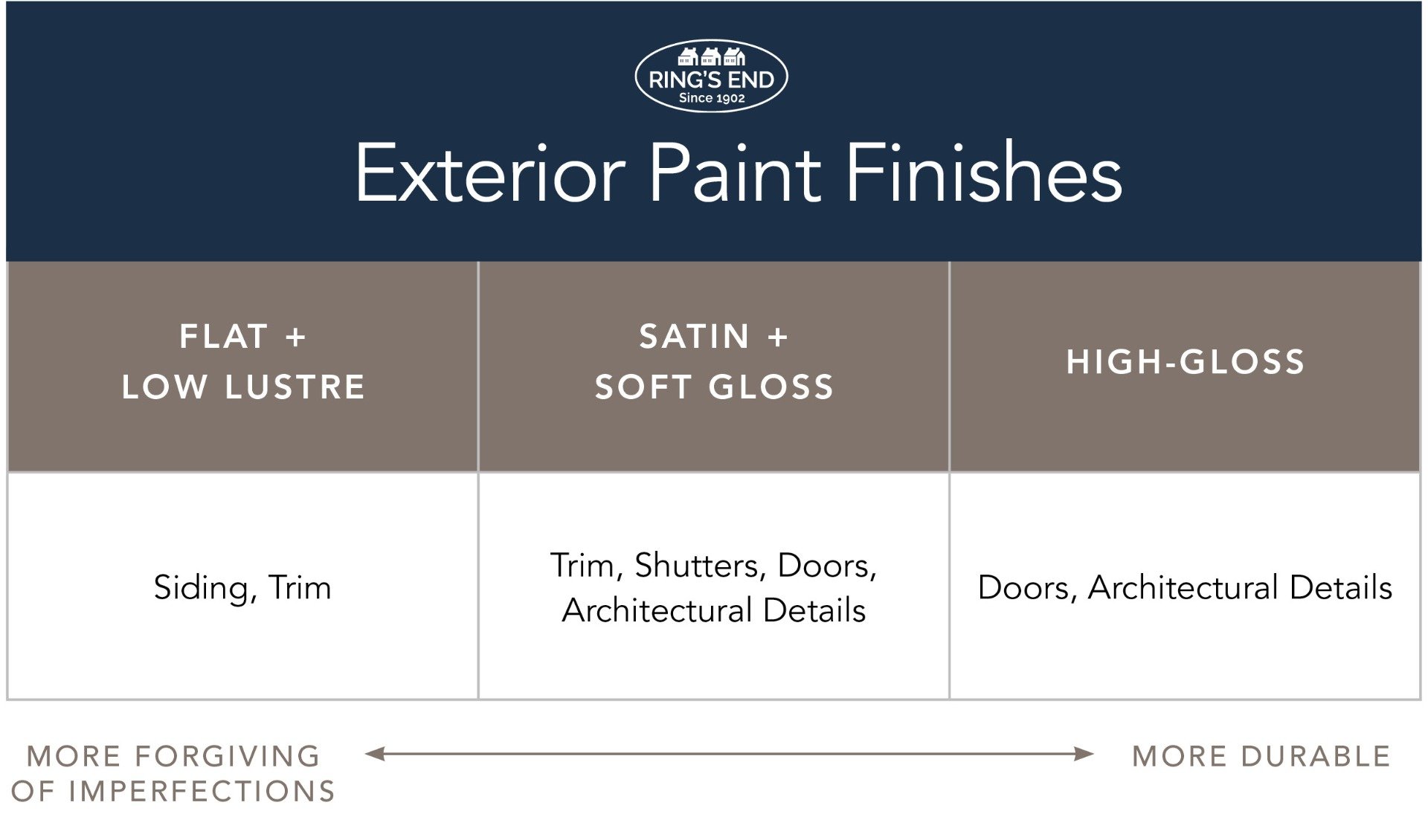
How to Test Exterior Paint
Our favorite designer tip for testing paint swatches on the exterior of your home is to paint a large poster board using a Benjamin Moore half-pint paint color sample – then move it around the outside of your home to observe the color in different lighting conditions.
Ring’s End carries a wide selection of Benjamin Moore paints in-store and online with shipping anywhere in the U.S. Try our Benjamin Moore Paint Color Samples that are popular with professional interior designers for creating large paint swatches. Shipping is free when you order at least four paint samples and on all orders over $150.
The Best Time of Year for Painting Exteriors
The best conditions for exterior painting are low humidity and temperatures between 40°F and 80°F. If it’s too hot, the paint will dry too quickly, and if it’s too cold or damp it may not cure properly. Note that it may take a week or more to finish the entire project, and bad weather can ruin a new paint job. Check the weather report and try to work during a dry week with mild temperatures.
Cost Assessment and Planning
Make sure you prep your supplies ahead of time so that once you get started you don’t have to interrupt your project. Costs will vary based on the type of paint you select and how many supplies you already own. Keep in mind that spending more money upfront on quality paint will pay off later with extended performance and durability. Here is a master list to consult as you prepare to paint your house exterior.
Paint & Primer:
- Exterior Paint
- Exterior Primer (if needed)
Project Supplies:
- Paint Brushes and Rollers for the type of paint you are using
- Drop Cloths or Plastic Sheets to protect the ground, plants, and other surfaces
- Painter’s Tape to mask off windows, doors and trim
- Ladders or Scaffolding, depending on the height of your home
- Caulk and Caulking Gun
- Putty Knife and Spackle (for wood surfaces) or Stucco Patch (for stucco)
- Paint Trays or Buckets
- Sandpaper and Sander
- Rags and Cleaning Supplies
- Pressure Washer for prep and cleaning
- Safety Gear including safety goggles, a dust mask, and gloves – especially when working with paint, caulk, or sanding surfaces
- Paint Sprayer (optional): For large areas like siding, consider using a paint sprayer for faster and more even coverage
How to Paint a House Exterior
Once you’ve gathered all your supplies and have a plan for your house exterior, these are the steps you’ll need to follow to successfully complete a paint job.
Clean and Prep Surfaces
- Clean the surface: Use a pressure washer and scrub brush to remove dirt, dust, and peeling paint. Allow the surface to dry for a couple of days before painting.
- Repair any damage: Inspect the exterior for cracks, holes, or rotted wood. Patch these areas with appropriate filler or caulk, and replace any damaged siding or trim.
- Protect surrounding areas: Cover windows, doors, plants, and other features with plastic sheets or painter’s tape to prevent splatter.
Apply Primer
Most exterior surfaces will need primer to ensure proper adhesion of the paint. Apply a single coat of your recommended primer to all surfaces.
Apply Two Coats of Paint
- Use a paint sprayer, roller, or brush to apply the paint. A sprayer is efficient for large areas like siding, while a roller and brush work best for small areas and woodwork.
- Work from top to bottom: Start painting from the top of each wall and work your way down to avoid drips and streaks.
- Follow the instructions: Pay attention to recommended drying times between coats for optimal results.
Find Resources for Your Home Exterior Paint Project at Ring’s End
Whether you’re giving your current home a makeover or personalizing new construction, you should love pulling into your driveway! Remember to take time to assess the exterior’s condition, find the right products, and schedule around the weather — and if you need help, text (203) PRO-HELP or chat with us online. The experts at Ring’s End are ready to help you find the best paint products for your home!



